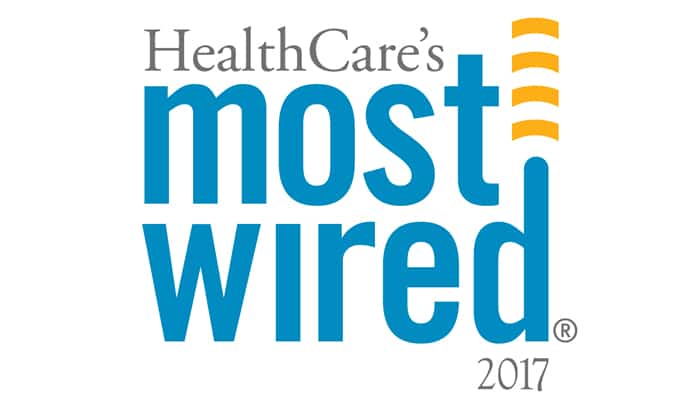Grady Named Most Wired For Sixth Consecutive Year
July 11, 2017
Technology is making it easier for patients and providers to interact, thus improving communication, safety and patient-provider relationships. New tools are helping patients become more actively involved in their care and maintaining their health, according to results of the 19th Annual Health Care’s Most Wired® survey, just released by the American Hospital Association’s (AHA) Health Forum.
According to the survey, Most Wired hospitals are using smart phones, telehealth and remote monitoring to create more ways for patients to access health care services and capture health information. This year’s results show:
- 76 percent offer secure messaging with clinicians on mobile devices.
- When patients need ongoing monitoring at home, 74 percent use secure e-mails for patients and families to keep in touch with the care team.
- 68 percent simplify prescription renewals by letting patients make requests on mobile devices.
- 62 percent add data reported by patients to the electronic health record to get a better picture of what is going on with the patient.
- Nearly half of the hospitals are using telehealth to provide behavioral health services to more patients.
- 40 percent offer virtual physician visits.
- More than 40 percent provide real-time care management services to patients at home for diabetes and congestive heart failure.
“For the sixth consecutive year, Grady has been one of the nation’s most wired health systems. This achievement clearly demonstrates the health system’s commitment to providing the highest quality patient care,” said Ben McKeeby, senior vice president and chief information officer, Grady Health System.
“The Most Wired hospitals are using every available technology option to create more ways to reach their patients in order to provide access to care,” said AHA President and CEO Rick Pollack. “They are transforming care delivery, investing in new delivery models in order to improve quality, provide access and control costs.”
Innovation in patient care embraces emerging technologies and underscores the need for secure patient information exchange. Hospitals have increased their use of sophisticated IT monitoring systems to detect patient privacy breaches, monitor for malicious activities or policy violations and produce real-time analysis of security alerts.
- 97 percent use intrusion detection systems.
- 96 percent perform data access audits.
- Nearly 90 percent run targeted phishing exercises to teach employees to question suspicious emails.
Most Wired hospitals are transforming care delivery with knowledge gained from data and analytics. They are investing in analytics to support new delivery models and effective decision-making and training clinicians on how to use analytics to improve quality, provide access and control costs.
- 82 percent analyze retrospective clinical and administrative data to identify areas for improving quality and reducing the cost of care.
- Three-quarters use sophisticated analytics such as predictive modeling and data to improve decision-making.
- Nearly 70 percent interface electronic health record data with population health tools for care management.
- More than 70 percent are providing data analytic tools training to physicians and nurses.
- 45 percent initiate a patient pathway using health IT to follow a care plan.
- Nearly 40 percent deliver quality metrics to physicians at the point-of-care.
- 32 percent have tools for real-time patient identification and tracking for value-based care conditions, such as chronic obstructive pulmonary disease.
HealthCare’s Most Wired® survey, conducted between Jan. 15 and March 15, 2017, is published annually by Hospitals & Health Networks (H&HN). The 2017 Most Wired® survey and benchmarking study is a leading industry barometer measuring information technology (IT) use and adoption among hospitals nationwide. The survey of 698 participants, representing an estimated 2,158 hospitals — more than 39 percent of all hospitals in the U.S. — examines how organizations are leveraging IT to improve performance for value-based health care in the areas of infrastructure, business and administrative management; quality and safety; and clinical integration.
Detailed results of the survey and study can be found in the July issue of H&HN. For a full list of winners, visit www.hhnmag.com.

